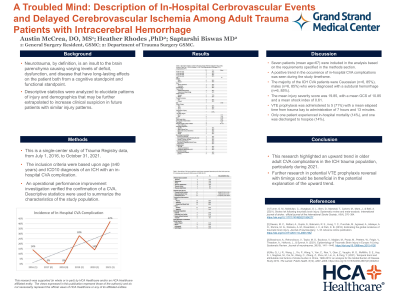Trauma
Category: Quickshot Oral Session 27
Quickshot Oral : Quickshot Oral Session 27
A TROUBLED MIND: DESCRIPTION OF IN-HOSPITAL CERBROVASCULAR EVENTS AND DELAYED CEREBROVASCULAR ISCHEMIA AMONG ADULT TRAUMA PATIENTS WITH INTRACEREBRAL HEMORRAGE
Tuesday, February 14, 2023
7:00am - 8:00am East Coast USA Time

- AM
Austin O. McCrea, DO (he/him/his)
Resident
Grand Strand Medical Center, United States - SB
Saptarshi Biswas, MD FACS
Attending, United States
Presenter(s)
Principal Contact(s)
Objectives: Neurotrauma, by definition, is an insult to the brain parenchyma causing varying levels of deficit, dysfunction, and disease that have long-lasting effects on the patient both from a cognitive standpoint and functional standpoint. Descriptive statistics were analyzed to elucidate patterns of injury and demographics that may be further extrapolated to increase clinical suspicion in future patients with similar injury
patterns.
Methods: This is a single-center study of Trauma Registry data, from July 1, 2016, to October 31, 2021. The inclusion criteria were based upon age (≥40 years) and ICD10 diagnosis of an ICH with an in-hospital CVA complication. An operational performance improvement investigation verified the confirmation of a CVA. Descriptive statistics were used to summarize the characteristics of the study population.
Results: Seven patients (mean age=67) were included in the analysis based on the requirements specified in the methods section. A positive trend in the occurrence of in-hospital CVA complications was seen during the study timeframe. The majority of the ICH CVA patients were Caucasian (n=6, 85%), males (n=6, 85%) who were diagnosed with a subdural hemorrhage (n=6, 85%). The mean injury severity score was 19.85, with a mean GCS of 10.85 and a mean shock index of 0.61. VTE prophylaxis was administered to 5 (71%) with a mean elapsed time from trauma bay to administration of 7 hours and 13 minutes. Only one patient experienced in-hospital mortality (14%), and one was
discharged to hospice (14%).
Conclusion: This research highlighted an upward trend in older adult CVA complications in the ICH trauma population, particularly during
2021. Further research in potential VTE prophylaxis reversal with timings could be beneficial in the potential explanation of the upward trend.
patterns.
Methods: This is a single-center study of Trauma Registry data, from July 1, 2016, to October 31, 2021. The inclusion criteria were based upon age (≥40 years) and ICD10 diagnosis of an ICH with an in-hospital CVA complication. An operational performance improvement investigation verified the confirmation of a CVA. Descriptive statistics were used to summarize the characteristics of the study population.
Results: Seven patients (mean age=67) were included in the analysis based on the requirements specified in the methods section. A positive trend in the occurrence of in-hospital CVA complications was seen during the study timeframe. The majority of the ICH CVA patients were Caucasian (n=6, 85%), males (n=6, 85%) who were diagnosed with a subdural hemorrhage (n=6, 85%). The mean injury severity score was 19.85, with a mean GCS of 10.85 and a mean shock index of 0.61. VTE prophylaxis was administered to 5 (71%) with a mean elapsed time from trauma bay to administration of 7 hours and 13 minutes. Only one patient experienced in-hospital mortality (14%), and one was
discharged to hospice (14%).
Conclusion: This research highlighted an upward trend in older adult CVA complications in the ICH trauma population, particularly during
2021. Further research in potential VTE prophylaxis reversal with timings could be beneficial in the potential explanation of the upward trend.

